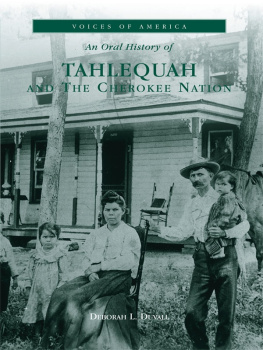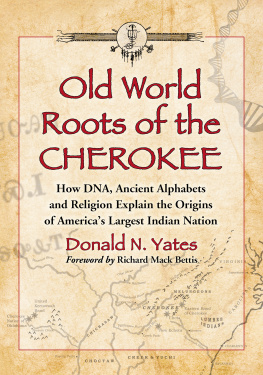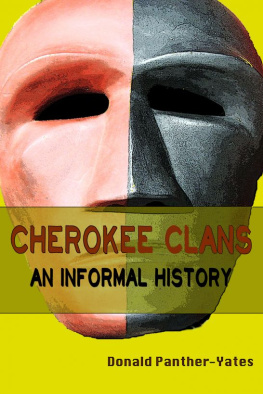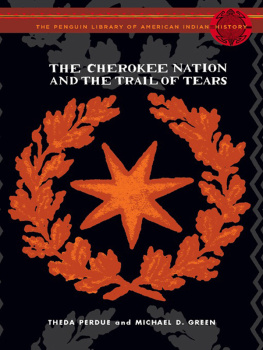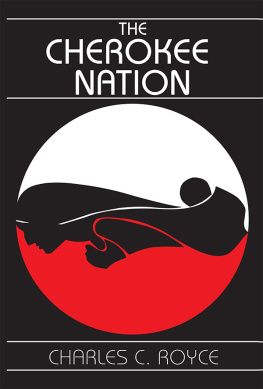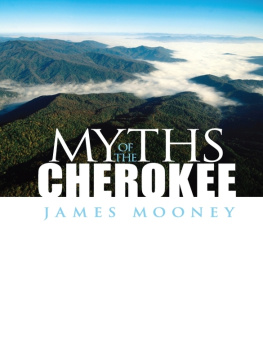The Seal of the Cherokee Nation. The seven pointed star in the center represents the seven Cherokee clans. It is surrounded by oak leaves. Oak was used in keeping the sacred fire in the townhouse. The Cherokee symbols following the words, Seal of the Cherokee Nation, are pronounced jalagihi ahyeli, and are translated, The Cherokee Nation. The date, September 6, 1839, is the date of the adoption of the constitution of the Cherokee Nation at its new home in the west following the Trail of Tears. The seal was adopted by the Cherokee National Council and approved by Chief Lewis Downing on December 11, 1871. Courtesy of the Cherokee Nation.
The Cherokee Nation
A History
ROBERT J. CONLEY
University of New Mexico Press
Albuquerque
ISBN for this digital edition: 978-0-8263-3236-3
2005 by Robert J. Conley and the Cherokee Nation
All rights reserved. Published 2005
Printed in the United States of America
Library of Congress Cataloging-in-Publication Data
Conley, Robert J.
The Cherokee Nation : a history / Robert J. Conley.
p. cm.
Includes bibliographical references and index.
ISBN 0-8263-3234-X (cloth : alk. paper)
1. Cherokee NationHistory. 2. Cherokee IndiansHistory.
3. Cherokee IndiansGovernment relations. 4. Cherokee IndiansSocial life and customs. I. Title.
E99.C5C716 2005
975.00497557dc22
2005006822
Cherokee Historical Novels
by Robert J. Conley
The Way of the Priests
The Dark Way
The White Path
The Way South
The Long Way Home
The Dark Island
The War Trail North
The Peace Chief
War Woman
Cherokee Dragon
Spanish Jack
Sequoyah
Captain Dutch
Mountain Windsong
Nickajack
Zeke Proctor: Cherokee Outlaw
Ned Christies War
Acknowledgments
The following people all graciously read the manuscript and provided comments and suggestions. I am grateful to them. Ray Fogelson, Rennard Strickland, Theda Purdue, Dan Littlefield, David Scott, Richard Allen, Wyman Kirk, John Ross, Duane King.
Mike Miller and Paulette Thomas worked on logistics and in collecting and documenting the illustrations, an often thankless job, but I do thank them.
Delores Sumner and her staff at the Special Collections Room in the John Vaughan Library, Northeastern State University, were a great help and, as always, are much appreciated.
My all too rare conversations with Tom Belt on Cherokee history and culture and language are always delightful and very informative.
The book would never have been written without Principal Chief Wilma Mankiller, Principal Chief Chad Smith, and Gloria Sly. The original contract with the Cherokee Nation came under the Mankiller administration. Chad Smith was tribal prosecutor, and Gloria Sly was head of the Cherokee Nations Education Department. These three people, together, conceived the idea and approached me with it. Chief Smith and Gloria Sly have been with me on this project from the beginning to the end, and I am very much in their debt.
A project like this could not be done alone. If I have left out anyone, I apologize for it. This has been a long process.
Chapter I: Theories and Legends
Contemporary Cherokees are the descendants of a large and powerful American Indian tribe that has existed since prehistory, further back than anyone can really say. No one knows for sure from whence the Cherokees originated. Many scholars still insist that all peoples native to the Americas came into America from Asia by way of the Bering Strait land bridge. They say that twelve thousand years ago, during the last ice age, there were no human beings in the Americas. Therefore, they say, there are no true natives of this land, only the earliest immigrants.
These earliest immigrants, they say, came down into North America from Asia across a land bridge that had formed during the ice age, linking the two continents. These people, they say, were simply wandering, i.e. nomadic, big-game hunters, and they were following the game. They apparently continued to follow it until they had spread out and covered two continents, North and South America, and as their population grew and they separated into different groups and eventually settled in different areas, slowly different languages and different cultures developed. Thats the theory that is still widely accepted, and at least one Cherokee migration legend might be seen to support this theory. Told originally by a Cherokee to an Englishman named Alexander Long in 1717 in Carolina, the tale was published in A Cherokee Migration Fragment by Corkran (and quoted in Thorntons population history), and it runs partly as follows. (The spelling has been modernized here and some few words provided in brackets to clarify the sense.)
For our coming here, we know nothing but what was had from our ancestors and has brought it down from generation to generation. The way is thus. [We] belonged to another land far distant from here, and the people increased and multiplied so fast that the land could not hold them, so that they were forced to separate and travel to look out for another country. They traveled so far that they came to another country that was so cold. Yet going still on, they came to mountains of snow and ice. The priests held a council to pass these mountains, and that they believed there was warmer weather on the other side of those mountains because it lay near the sun setting. [It] was believed by the whole assembly we were the first to make [snowshoes] to put on our old and young. [We} passed on our journey and at last found [ourselves] so far gone over these mountains till we lost sight of the same and went through darkness for a good space, and then [saw] the sun again, and going on we came to a country that could be inhabited. (Thornton, p. 6)
At least one scholar, Dr. Jeffrey Goodman, in his book American Genesis , takes exception to that theory. As far as the Bering Strait migration theory is concerned, Goodman maintains that just the opposite from the standard belief probably occurred. He says that Modern Man existed in North America, specifically in what is now Southern California, at least fifty thousand years ago, at a time when Europe and Asia were still populated by Neanderthal Man.
He further speculates that there is no missing link between Neanderthal Man and Modern Man, because the two were never linked in the first place. The Bering Strait migration did take place, Goodman says, but it involved the migration of Modern Man from America as he moved north into Asia and then into Europe to displace the Neanderthals. That too is a theory, and like the other, it is based on a certain amount of evidence followed by speculation. One theory is perhaps as good as the other. And more recently, some scholars have begun to argue that there could have been several, if not many migrations into the Americas, from Asia and from islands in the Pacific Ocean.
And Vine Deloria, Jr., in his Red Earth, White Lies (Scribner, 1995), says that some of his history colleagues were beginning their courses on American history with a mindless recitation of the Bering Strait theory....Basically they were simply repeating scholarly folklore, since there is, to my knowledge, no good source which articulates the theory in any reasonable format. Indeed, this theory has been around so long that people no longer feel they have to explain or defend itthey can merely refer to it. Later he says The Bering Strait exists and existed only in the minds of scientists.




